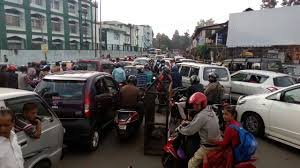Shillong, Meghalaya (March 21, 2025):
The picturesque hill station of Shillong, once known for its serene beauty and colonial charm, is now buckling under the pressure of severe traffic congestion. Once considered the “Scotland of the East,” the city is increasingly struggling to cope with rapid urbanization, unregulated vehicle growth, and poor infrastructure, sparking serious concerns among citizens, urban planners, and environmental experts alike.
The question now looms large: Is Shillong heading toward an urban disaster?
Choked Roads and Rising Chaos
Every day, thousands of vehicles clog Shillong’s narrow roads, many of which were not designed to handle the volume of modern-day traffic. What was once a peaceful commute has now turned into hours-long gridlocks, especially during school hours, office times, and tourist seasons.
- Key intersections like Police Bazaar, Laitumkhrah, and Motphran experience daily bottlenecks.
- Delivery trucks, school buses, taxis, and private vehicles all jostle for space in the city’s inadequate road network.
- Emergency services often face delays due to blocked roads, causing serious public safety concerns.
Causes of Shillong’s Traffic Crisis
Experts attribute the congestion to a combination of factors:
- Uncontrolled vehicle growth:
- Shillong has seen a massive rise in vehicle ownership, with limited restrictions on vehicle registration.
- Lack of public transport infrastructure:
- The city lacks a reliable, efficient public transport system, forcing residents to rely on private vehicles and shared taxis.
- Poor urban planning:
- Shillong’s hilly terrain and unplanned expansions have left little room for road widening or alternative traffic routes.
- Unregulated construction:
- Rapid commercial and residential development without traffic impact assessments has worsened road usage.
- Tourism boom without infrastructure boost:
- As a major tourist destination, Shillong attracts thousands of visitors annually, but hasn’t scaled its infrastructure accordingly.
Impact on Daily Life and Environment
The effects of traffic congestion go beyond inconvenience:
- Public frustration is at an all-time high, with locals expressing concern over deteriorating quality of life.
- Air and noise pollution levels are rising steadily due to idling engines and honking in slow-moving traffic.
- Schoolchildren and elderly citizens often face challenges in commuting due to long travel times and poor pedestrian infrastructure.
- Local businesses report reduced customer footfall and delayed deliveries.
Is There a Way Forward?
Urban planning experts and local activists are calling for urgent interventions before the situation becomes irreversible. Proposed solutions include:
- Introducing vehicle restriction policies, such as odd-even schemes or limiting registration of new vehicles.
- Developing dedicated parking zones to reduce roadside parking.
- Expanding public transport, including shuttle services and electric buses.
- Improving pedestrian walkways and cycling infrastructure.
- Smart traffic management systems to monitor and regulate flow more efficiently.
A senior town planner remarked:
“Shillong is at a tipping point. Without immediate and coordinated action from both the government and the public, the city risks losing its liveability and natural charm.”
Conclusion: Time is Running Out
Shillong’s traffic congestion is no longer a minor inconvenience—it’s a full-blown crisis. If left unaddressed, the city’s infrastructure collapse could have economic, social, and environmental consequences for years to come.
As Meghalaya’s capital and a tourism hub, Shillong deserves a vision for sustainable urban mobility and long-term development. But that vision must translate into action—before gridlock becomes collapse.

